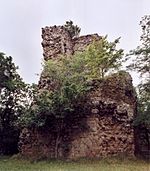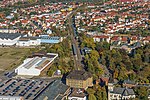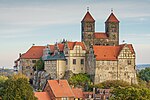Weddersleben
Former municipalities in Saxony-AnhaltHarz district geography stubsThale
Weddersleben is a village and a former municipality in the district of Harz, Saxony-Anhalt, in the Harz area. Since 1 January 2009, it is part of the town Thale. The village is well known for being located adjacent to the famed natural rock formation known as the Teufelsmauer, or "Devil's Wall" in English. Surrounding forest area has numerous paths for biking and hiking, making it a popular tourist destination for nature seekers. Among the many natural formations in the area, the Bode River flows by the edges of the village.
Excerpt from the Wikipedia article Weddersleben (License: CC BY-SA 3.0, Authors).Weddersleben
Friedensstraße,
Geographical coordinates (GPS) Address Nearby Places Show on map
Geographical coordinates (GPS)
| Latitude | Longitude |
|---|---|
| N 51.764722222222 ° | E 11.086944444444 ° |
Address
Friedensstraße 4
06502 (Weddersleben)
Saxony-Anhalt, Germany
Open on Google Maps





